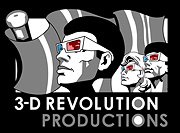A short refresher on 3-D film history

Chicken Little in 3-D by Disney
3-D film, or stereoscopic film, is a peculiar art form. Stereoscopy, the art of displaying images the way we see them with our two eyes - and combining brain - has been around since the renaissance. The moment these visionary painters understood space and the ways eyes see space better, they were experimenting with drawings in stereo. And so 3-D photography has been around as long as regular photography has, yet it has always stood in the shadow of its natural brother. There is no problem at all in placing two lenses next to each other instead of just one, using the same film but splitting the image on the negative in two for left-eye and right-eye image representation. But a device is then needed to view the stereoscopic photograph; a stereo viewer - on which the Viewmaster™ was later based. This necessity of an external viewer has always been an inhibition to a visual art form, which should have overtaken regular photography as the going standard. It never did because the obstacle of the viewing device proved to be too great a one. After building the first practical movie camera in history, the Lumiere brothers built a stereoscopic one as well. A lot of their experimental film is actually one of the two reels they normally used to shoot their 3-D. The arrival of a train at la Ciotat (1895) was filmed in 3-D as well as ‘flat’, so the audience did not just run from a train on screen for the first time, they ran for a train approaching them in 3-D for the first time! However much more spectacular 3-D film proved to be over regular film, the necessity of a viewer, now often a pair of anaglyphic red-blue glasses, did again keep it down in terms of popular acceptance.
After building the first practical movie camera in history, the Lumiere brothers built a stereoscopic one as well. A lot of their experimental film is actually one of the two reels they normally used to shoot their 3-D. The arrival of a train at la Ciotat (1895) was filmed in 3-D as well as ‘flat’, so the audience did not just run from a train on screen for the first time, they ran for a train approaching them in 3-D for the first time! However much more spectacular 3-D film proved to be over regular film, the necessity of a viewer, now often a pair of anaglyphic red-blue glasses, did again keep it down in terms of popular acceptance.
It is safe to say distributors promoting recent film releases in 3-D are twisting the truth when they claim they have just released the first feature length 3-D film in history because this was done as early as 1922, by an American film called ‘The Power of Love’. The audience would wear 3-D glasses very similar to the modern frame-sequential IMAX glasses, but with the distinct difference of being mechanical rather than electronic to control the shutter closing the left-eye and right-eye side in sequence. Again, distributors and sales people love to proclaim this is all very new technology, painting the brilliant stereoscopic cinematic inventors of a century ago out of the picture.![]()
![]()
![]()
![]()
![]()
![]()
![]()
![]()
![]()
![]()
![]()
![]()




